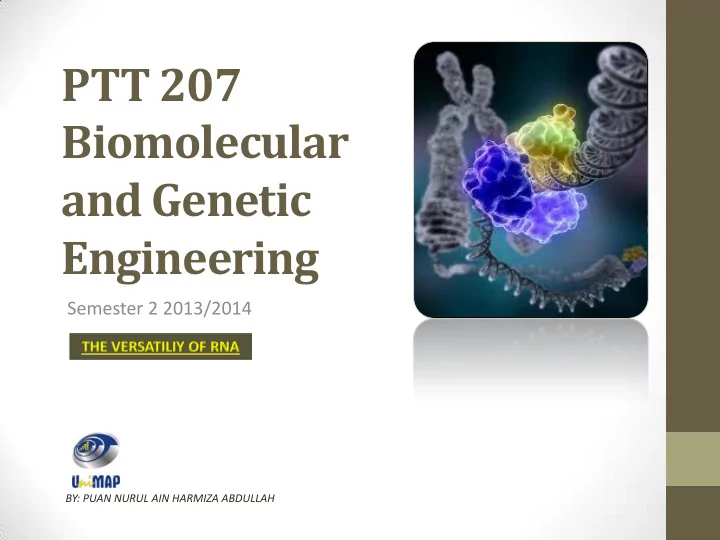

PTT 207 Biomolecular and Genetic Engineering Semester 2 2013/2014 BY: PUAN NURUL AIN HARMIZA ABDULLAH
Content I. INTRODUCTION II. RNA IS INVOLVED IN A WIDE RANGE OF CELLULAR PROCESSES III. STRUCTURAL MOTIFS OF RNA
3.1 INTRODUCTION
INTRODUCTION • Chp 1 - Properties of DNA Chp 3 - Properties of RNA • RNA is now known to be involved in a wide range of essential cellular processes from DNA replication to protein synthesis. • The bottom line is that RNA has a much greater structural versatility compared with DNA.
3.2 RNA IS INVOLVED IN A WIDE RANGE OF CELLULAR PROCESSES
RNA is involved in a wide range of cellular processes • RNA is genetic information responsible for the synthesis of proteins. • The 6 major types of RNA are as follows: 1. Ribosomal RNA (rRNA) 2. Messenger RNA (mRNA) 3. Transfer RNA (tRNA) 4. Small nuclear RNA (snRNA) 5. Small nucleolar RNA (snocRNA) 6. MicroRNA (miRNA)
1. Ribosomal RNA (rRNA) • rRNA is responsible for attaching new amino acids to the growing chain that will eventually make up a protein. 2. Messenger RNA (mRNA) • A single strand copy of a coding strand of DNA copied during a process called transcription. 3. Transfer RNA (tRNA) • tRNA carries amino acids to ribosomes in order to make sure the correct amino acids are inserted into newly created proteins during protein synthesis. 4. Small nuclear RNA (snRNA) • Plays a role in pre-mRNA splicing, a process which prepares the mRNA for translation. 5. Small nucleolar RNA (snocRNA) • Plays a role in rRNA processing. 6. MicroRNA (miRNA) • Involved in post-transcriptional gene regulation; each miRNA binds to a complementary sequence in a target mRNA, usually resulting in gene silencing, by triggering degradation of mRNA or by blocking translation by the ribosome.
Relationships among the 6 major types of RNA during gene expression.
Two key points for understanding RNA function • RNA can form complementary base pairs with other nucleic acids. • RNA can interact with proteins: Ribonucleoprotein (RNP) particles
3.3 STRUCTURAL MOTIFS OF RNA
Structural motifs of RNA • RNA is a chain-like molecule composed of subunits called nucleotides joined by phosphodiester bonds. • Each nucleotide subunit is composed of 3 parts: • A ribose sugar • A phosphate group • A nitrogenous base (adenine, guanine, cytosine, uracil ) • Single-stranded RNA molecules fold into a variety of secondary structural motifs that are stabilized by both Watson-Crick and unconventional base pairing.
Secondary structure of RNA • In Lecture 2, the DNA double helix forms from 2 separate DNA chains. • In RNA, helix formation occurs within one ssRNA chain of nucleotides. • As for DNA, the RNA helix is stabilized by H-bonds between base pairs and base-stacking hydrophobic interactions.
Base-paired RNA adopts an A-type double helix • RNA adopts a right-handed A-type double helix with 11 bp per turn . • The 2’ -hydroxyl group of the ribose in RNA hinders formation of a B-type helix (the predominant form in dsDNA) but can be accommodate within an A-type helix. • RNA is often recognized by RNA-binding proteins in the minor groove.
RNA helices often contain noncanonical base pairs • RNA double helices often contain noncanonical or non-Watson Crick base pairs . • There are >20 different types of noncanonical bp that have been found in RNA structures which includes the : 1. GU wobble 2. GA sheared 3. AU reverse Hoogsteen 4. GA imino
RNA structures often contain unconventional base pairing Base triples • Typically involve one standard base pair (most commonly either a Watson-Crick or a reverse Hoogsteen pair). • The third base interacts in a variety of unconventional ways.
Noncanonical base pairs and base triples Important mediators of: • RNA self-assembly. • RNA-protein interactions. • RNA-ligand interactions.
So, does these base interactions have any functional significance? • Yes, noncanonical base pairs and base triples are important mediators of RNA self- assembly and of RNA-protein and RNA-ligand interactions. • For example, noncanonical bp widen the major groove and make it more accessible to ligands.
Bases in loops and bulges that are supposedly unpaired are often involved in a variety of long- range interactions, forming noncanonical bp.
Tertiary structure of RNA • Examples of some common motifs are: • Pseudoknot motif • A-minor motif • Tetraloop motif • Ribose zipper motif • Kink-turn motif • Kissing hairpin loop
Tertiary structure of RNA • The 3D structure is maintained by interactions between distant nucleotides and interactions between 2’ -OH groups. • These long range interactions are less stable than Watson-Crick bp and can be broken under mild denaturing conditions. • Recall that RNA is negatively charged ; thus tertiary structure formation is a process that requires charge neutralization either through binding of a basic proteins or through binding of monovalent and/or divalent metal ions.
The End Thank You
Recommend
More recommend